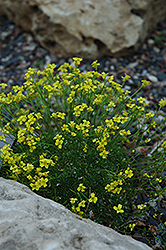Height: 3 inches
Spread: 6 inches
Sunlight:
![]()
Hardiness Zone: 2a
Description:
A sun loving, easy to grow and low maintenance selection perfect for rock or alpine gardens; small clusters of yellow flowers contrast against green grass-like foliage during the early spring months; foliage continues through the season
Ornamental Features
Bryoides Whitlow Grass has clusters of yellow flowers at the ends of the stems in early spring, which are interesting on close inspection. Its grassy leaves remain green in colour throughout the year.
Landscape Attributes
Bryoides Whitlow Grass is an open herbaceous evergreen perennial with a ground-hugging habit of growth. It brings an extremely fine and delicate texture to the garden composition and should be used to full effect.
This is a relatively low maintenance plant, and should be cut back in late fall in preparation for winter. It has no significant negative characteristics.
Bryoides Whitlow Grass is recommended for the following landscape applications;
- Rock/Alpine Gardens
Planting & Growing
Bryoides Whitlow Grass will grow to be only 3 inches tall at maturity, with a spread of 6 inches. Its foliage tends to remain low and dense right to the ground. It grows at a slow rate, and under ideal conditions can be expected to live for approximately 10 years. As an evegreen perennial, this plant will typically keep its form and foliage year-round.
This plant should only be grown in full sunlight. It prefers dry to average moisture levels with very well-drained soil, and will often die in standing water. It is considered to be drought-tolerant, and thus makes an ideal choice for a low-water garden or xeriscape application. It is particular about its soil conditions, with a strong preference for sandy, acidic soils. It is somewhat tolerant of urban pollution. This is a selected variety of a species not originally from North America. It can be propagated by division; however, as a cultivated variety, be aware that it may be subject to certain restrictions or prohibitions on propagation.
Disclaimer - This resource is provided for informational purposes only and does NOT reflect current availability. Inventory varies seasonally, so we cannot guarantee that every plant will be in stock at all times - please contact your favourite GardenWorks location directly for current availability. It does not include our entire inventory of plants, so be sure to visit GardenWorks to see varieties that may not be represented on this list.

